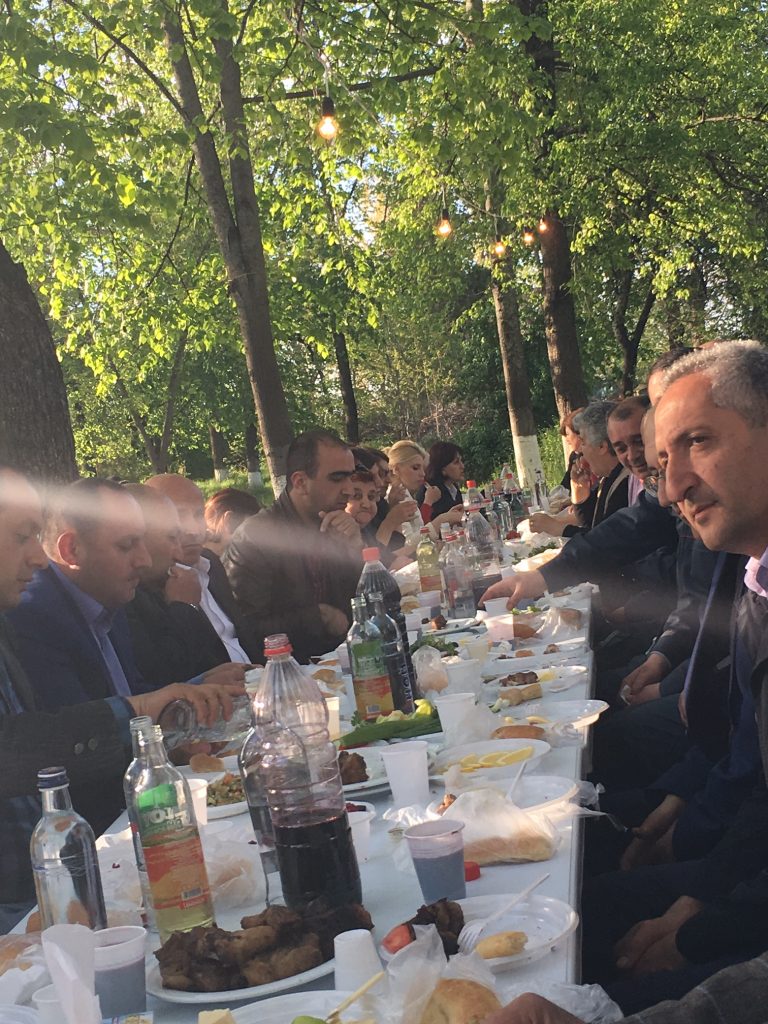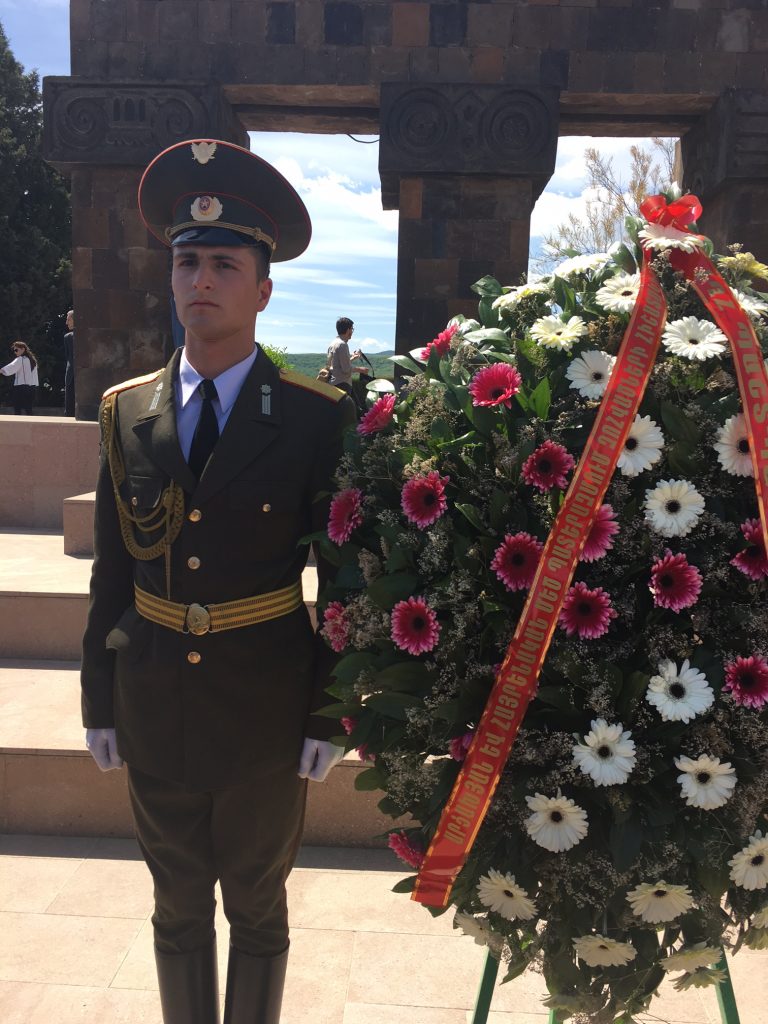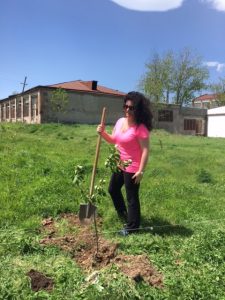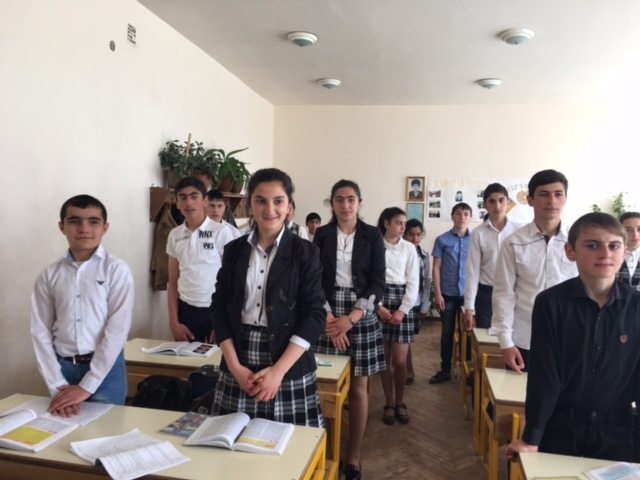Special for the Armenian Weekly
“It wasn’t an ordinary trip to Armenia,” I told my family with tired certainty, recollecting the whirlwind of places I’ve been and things I have seen.
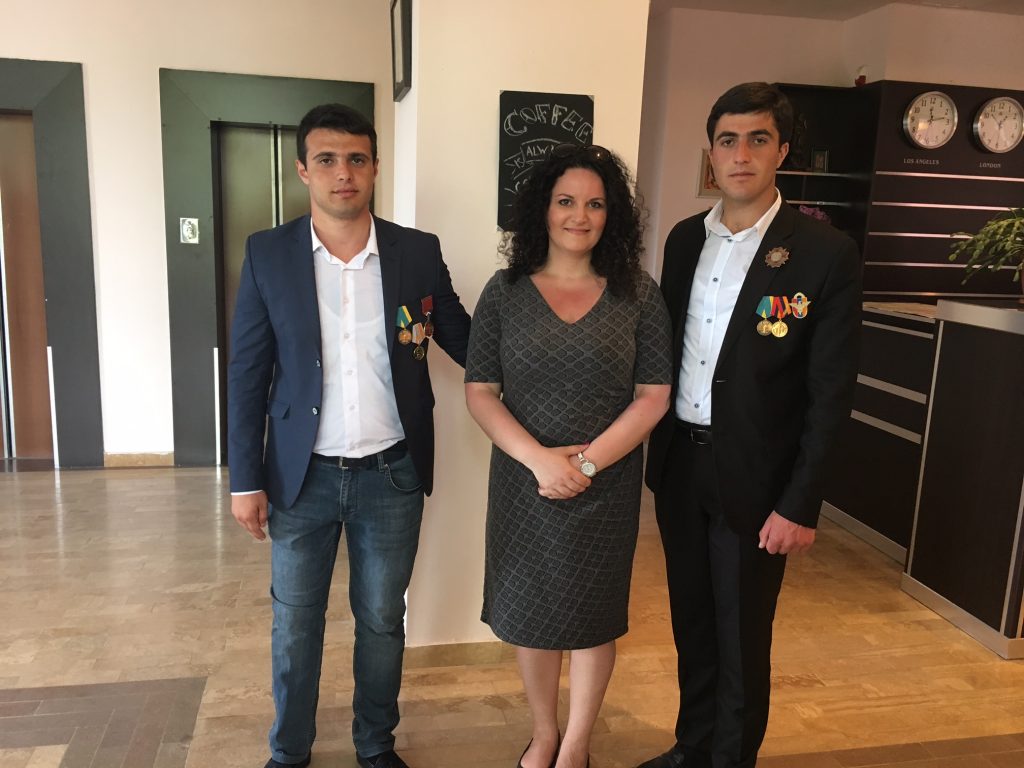
Gor Darmanyan and Gevorg Manukyan, both decorated war veterans with Anna in Shushi, Artsakh on Victory Day (May 9)
In 2016, I was in Armenia three times for various conferences and projects and the three trips combined could not even come close to the myriad of emotions I experienced this time around. Maybe it was because it was jam-packed; maybe it was a right combination of events. But truly, it is the people that I met that kept me awake the last few nights, wondering if I am doing enough and if I am focused enough on the things that are important for Armenia while I am back in the U.S.
My trip started with a flight to Yerevan through Dubai, landing smoothly in a familiar airport. The first time I landed in Zvartnots I was an 11-year-old refugee from Baku. The touchdown was a thick black line of tar drawn on my life—a line of “before” and “after” the events that shaped me into the person I am today.
That landing, like every landing onto Armenia’s soil, made my eyes water. This is true every time, regardless of whether or not I see Mount Ararat. That symbol is never important to me. Ararat is simply a silent observer of the continuation of life that’s on the ground in Armenia; the sole purpose of my trip then and the subsequent trips to follow.
It was a late afternoon, May 5, and I barely unpacked. I walked around the city, had dinner with an old best friend—Emma from School #132—and fell asleep in a jet-lag daze. The next morning at 9 a.m., a car picked me up to take me to Artsakh. The Russian version of my book, Nowhere, a Story of Exile was being launched in Stepanakert on May 7. It was important to me to release it there and it was important for me to be there for the 25th anniversary of the liberation of Shushi. The morning drive through the countryside lead me through familiar green mountains, live trains of sheep blocking the road, horses running freely along the side the road, and the dew rising from the new grass.
I brought my knitting for the long drive—wool children’s mittens, which was a mistake the minute we left the Ararat valley. The movement of the car around the steep mountainside as I was knitting brought on a familiar motion sickness. I smiled to myself, defeated, and looked outside instead, enjoying the equally nauseating and terrifying view of a rain downpour onto steep mountain roads for the next four hours of the drive. I cursed in my head at Azerbaijan, for not allowing any aircraft to fly into Stepanakert. The road to Arstakh is so long and there are so many people from the Diaspora that opt out from seeing Artsakh’s magnificent beauty simply due to inconvenience.
When we reached Syunik, my driver stopped in the village of Karashen. Few months prior to my trip I was informed by a distant cousin that there was a large family that was very close to my great grandmother’s line, specifically her brother’s family that we never knew about. As we pulled in, I noticed these people’s faces. I was stunned at the strong resemblance, especially one of them who looked just like my father, Norik. I pulled the phone out of my bag to take photos and some knitting yarn came along with it. My newly found beautiful cousin Anush—probably named after my great grandmother—saw my knitting, smiled broadly, and brought out her own knitting to show me. It was a gorgeous dress, knit neatly and meticulously on thin needles. With my parents’ art, my obsession with writing, painting, and needlework, the artistic and creative gene runs deep, I thought. And she was named Anush—as I should have been—though my location of birth prevented such a thing. Living in Baku I was named Anna instead.
After a brief lunch with this warm family in their lovely village house, we got back on the road. Before we left, the family made me promise I will stop by for khorovadz (barbeque) on the way back from Artsakh. I couldn’t say no.
Once in Stepanakert, I prepared for my presentation, which was hosted by the Artsakh’s Ministry of Culture. Although an exciting thing for me personally, I was more interested in the conversation with the audience members—questions that people asked me as a member of the Diaspora. They wanted to know what we thought of their liberation movement. They asked me why I did not speak Armenian. They wanted to know what I wished for them. It was hard not to show any emotion to these wonderful people, who came to hear about my book, which describes my life in Baku. That life is nowhere as heroic or interesting as the life they lead working daily and raising their children under the threat of foreign invasion. I was completely humbled, once again, as it happens every time I visit Artsakh.
The first day there, my friend Saro Saryan, a veteran of Artsakh liberation war and a fellow Baku refugee, took me to see Tigranakert and showed me the Line of Contact (LoC)—a dark line in the distance. Right in front of the LoC, on the way up to the church that overseas the Tigranakert ruins, elderly refugees were gathering wild thyme, unfazed by the presence of the enemy in the near distance. One of them, a little elderly woman, strong and feisty, greeted Saro warmly. He introduced her as Aunt Rima, a survivor of Sumgait massacres. She has been in Artsakh ever since. “Are you not afraid of snakes?” I asked the women. They laughed answering, “Snakes are afraid of us.” When we drove down the mountain on the way back, Aunt Rima ran down to meet our car and gave me the most fragrant bouquet of the herbs she collects to sell. I could not take it, but she insisted.

Anna (refugee from Baku) with Aunt Rima (refugee from Sumgait) in Artsakh near Tigranakert, with the LoC behind them in the distance.
The next day, I took a cab to Shushi, where I remained until I left Arstakh. I had a full day to explore the city, lined with both new buildings and gutted buildings completely destroyed by war 25 years ago. Sprinkled amongst this dichotomy of images are many museums Shushi has to offer. The Art Museum was the highlight of my day. I was amazed at the amount of art pieces that were donated to the Museum by loving patrons from all corners of the world. The many artists that come and donate their time to create pieces of work also surprised me. I often heard in my travels that we survive as Armenians through creating beauty. I could not imagine a better place to demonstrate this truth as I saw it bold and rugged in Shushi, liberated 25 years ago, standing tall, beautiful, and yet never forgetting the actual price of liberation.
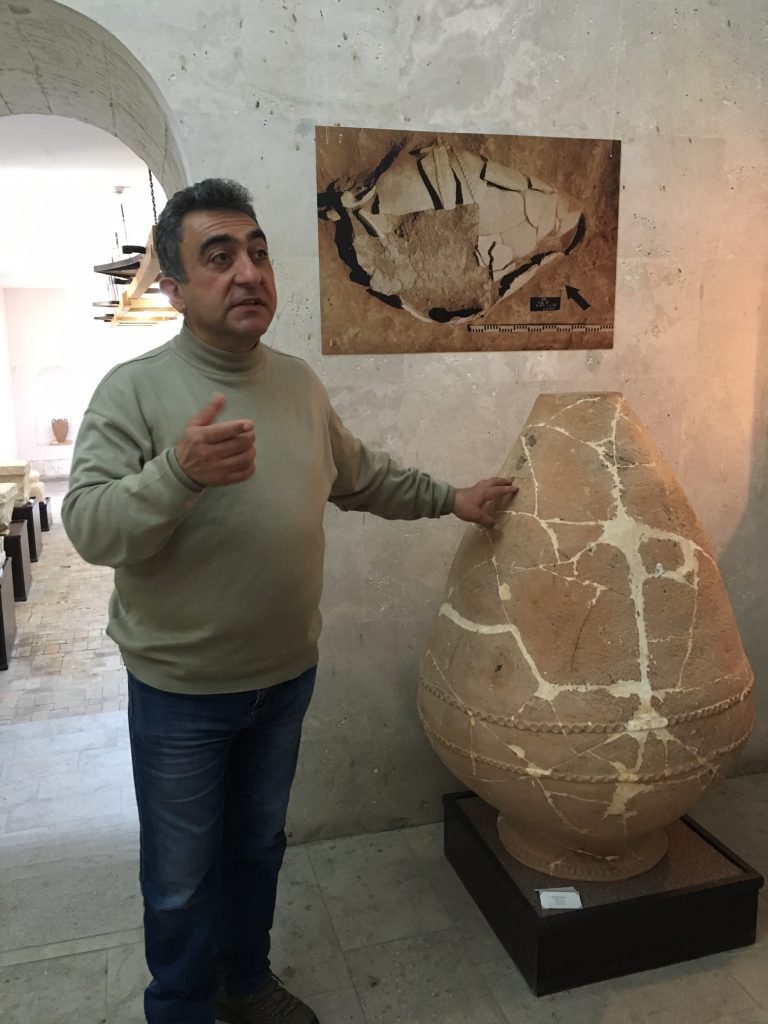
Saro Saryan, Head of the Shushi Geological Museum is an Artsakh war veteran and Baku refugee, shown here in the Tigranakert Museum with a 1,000 year old burial urn. (Photo: Anna Astvatsaturian Turcotte)
Nothing could have described this homage to the past victory better than a gathering of Shushi veterans for the celebration dinner in the local park, with food and drink. Hundreds of them gathered under the trees sitting at long tables, celebrating each other. I was invited by dear friends, but felt out of place sitting at the same table, watching these giants of history toast to each other, receiving medals, making speeches, carrying their nation on their shoulders for 25 years. Everything accomplished by this country would not have been a reality without their heroic actions–with limbs or lives lost, with terrible memories of sacrifices for the sake of liberation of their home and for their children.
I saw old veterans and I saw young veterans dancing with them. There is nothing that separates them but time. They continue the liberation: fathers, then sons, then their babies, and this is what I find the West misses to understand, including many in the diaspora. The conflict is not frozen. The conflict makes young kids march to the border and sacrifice their lives for their families back home. There is nothing frozen about this reality.
Living in U.S. and reading about 20-year-olds killed and wounded on Artsakh and Armenia’s borders is no longer surprising. Their names blend together with dates of birth ranging from 1995-1999. We mourn with the families of the fallen and pray for the relief of the complicated health conditions the wounded will carry for years to come. But we never meet them, we never touch their hands and look them in the eyes. Not where I live. Not often. But on this trip, I was honored to meet such heroes. I met two boys and nothing prepared me for the emotional and profound impact this would bring me then and probably for the rest of my life.
I met Gor Darmanyan and Gevorg Manukyan by chance. After the May 9 celebration in Stepanakert and Shushi with both Armenia and Artsakh’s Presidents laying flowers on the graves of the fallen, I was introduced to these brave young men. When introduced, I was in awe of how young they were; their baby faces did not match their eyes of permanently thoughtful, grown men.
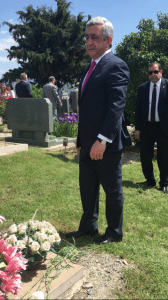
President Sarkisian laying flowers on the graves of the fallen soldiers in Stepanakert (Photo: Anna Astvatsaturian Turcotte)
I wondered the horrors they have seen and thanked God they were alive. One of the young men was Gevorg Manukyan; he is a decorated hero of the April 2016 war. Gevorg was stoic and polite shaking my hand, not letting on the fact that he shot and brought down an Azerbaijani helicopter infiltrating Artsakh border, along with the 22 crew members on board. He is studying law at the Yerevan State University. Gor was also a decorated hero, barely surviving many injuries few years earlier, losing a leg on March 19, 2015, bravely repelling the infiltration attempt of the Azerbaijani aggressor. He is now a shy student at the Yerevan State University studying law as well.
After we took a photo together, I could not come up with the right words. I finally simply said “thank you.” I also told these young men that we are very proud of them in the U.S. Gor smiled and seemed surprised. I could not believe that he was surprised. But yes, we are proud, Gor, despite the distance and our distorted view of the situation in Artsakh. If nothing else, people in the U.S., who work for Artsakh’s liberation and their right to self-determination, honor—by our continued commitment to the people of Artsakh—the sacrifices you’ve made for the Motherland.
The day ended with an enormous rock concert in Stepanakert celebrating the liberation anniversary. A taxi brought me back to the Shushi Avan Plaza Hotel. The driver was a Sumgait refugee as well. He fled the atrocities, and like so many refugees from Azerbaijan, settled in Artsakh and fought for its independence. The brief yet intensely deep conversation with him was symbolic to me. It shaped in my mind the importance for me to highlight the history of my people so that it may never be repeated. And that is what I have been doing and that is what I intend to continue doing for the people of Artsakh.
Leaving Artsakh was difficult but I knew I had to leave. My friends at the Armenia Tree Project (ATP) Lucineh Kassarjian and Arthur Harutyunyan were waiting. We were planting trees around the school in Khndzoresk village, my grandfather’s village he left during the Armenian Genocide to seek refuge in Baku. ATP does amazing work re-greening Armenia with communities that are committed to taking care of the trees they plant. ATP planted hundreds of trees around the school and the school uses the fruit to make juice and snacks for the school lunches.
I do not think my ATP friends realize that it is not just the fruit trees for the village kids that are important to me when I ask them to plant around Khndzoresk. I come back to the area to honor the memory of my grandparents with these trees. Yegishe and Tamar Astvatsaturovs’ graves in Baku were demolished in the early 1990s. There is no headstone for us to put our head onto and talk to any of our ancestors. But the roots of these young trees go deep into our land, the land that hums to me every time I am there. And that is how I connect to my family long past.
While at the school I had to check on the great progress of the three bathrooms recently remodeled by the Paros Foundation with the help of Armenian Network of America – Los Angeles chapter. A few years ago, when I visited the school, I learned the bathrooms did not have proper running water or functioning toilets. But that is all changing. I visited with some students and the faculty. The three out of the seven bathrooms, which were remodeled with the donated $10,000, are girls’ bathrooms located on the right side of the building spread out on three floors. I am told boys are extremely jealous that girls get to use a new bathroom. Currently, Paros is fundraising to finish the project, so that boys and faculty too can use functioning flushing bathrooms with running water.
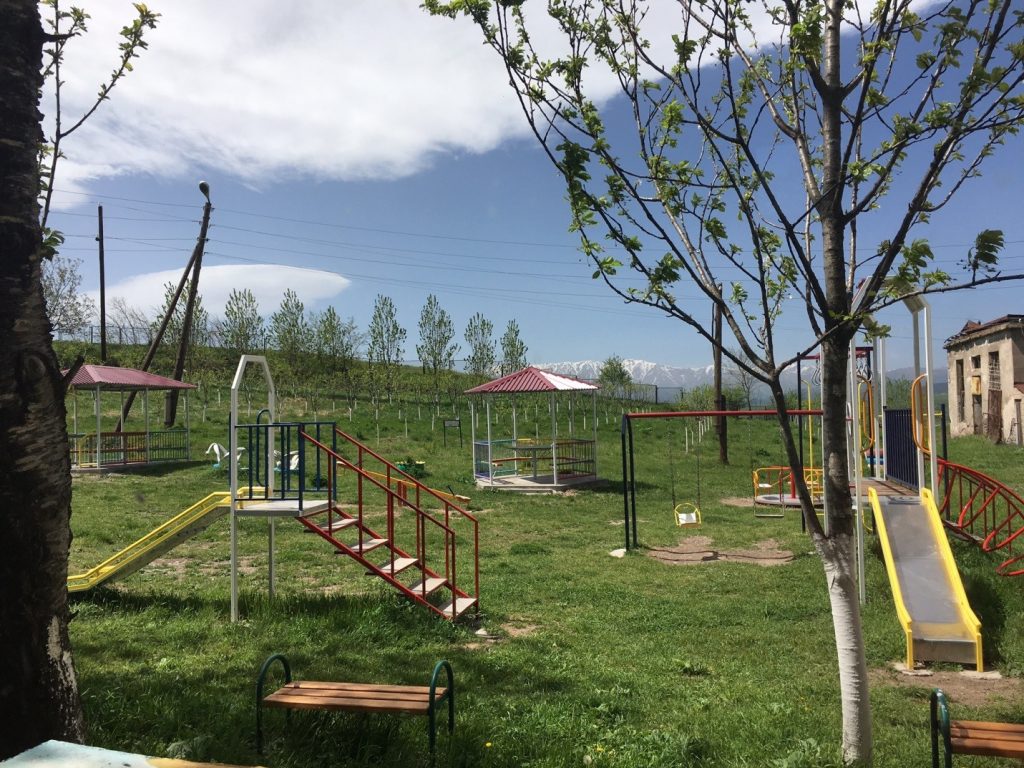
Khndzoresk school yard with fruit trees in the background provided by ATP (Photo: Anna Astvatsaturian Turcotte)
On the way back to Yerevan we stopped at Noravank where ATP planted thousands of trees. Arthur Harutyunyan of ATP is an unsung hero. He refused to let me take his photos. He deeply cares about the forests he creates and maintains with the communities that work with him. Lucineh, the Country Director, is a warm and inviting person, who is knowledgeable on the Project’s purpose and the impact it has on the country. With her and her excitable passion, I want to visit every beautiful ATP nursery, no matter where, no matter how far.
I got to Yerevan late that evening. The next morning I presented my newly translated book at the Armenian Genocide Museum. It was a surreal experience talking about my book at this sacred place so soon after returning from Artsakh. Retelling the memories of my grandfather surviving both the events of 1915 and 1918, and then our own experiences with ethnic violence in Baku, echoed in my head for hours to come. Through the audience, I understood that there is a clear misunderstanding of the diaspora by Armenians in the country. I hoped I bridged that with my presentation. I hope I bridge that with every conversation and with every presentation.
Before I left Armenia, I met yet another group of amazing people that make a difference in the lives of the everyday Armenians around the country. Few months prior to the visit, I reached out to the Armenian EyeCare Project (AECP) to see if the work they do ever reaches the Baku Armenian communities living in the various dormitories. At first, they mentioned that they only work within rural communities, but were willing to research the need of the vulnerable Baku communities. I knew when I came to Armenia they would brief me on the progress. But I had no idea they were superhuman…
In a short period of time, the AECP organized 220 free eye screenings of refugees living in Nork, Charbakh and Abovyan dormitories, prescribed 145 eyeglasses and performed eight surgeries for those in need. The surgeries were performed in the AECP Mobile Eye Hospital (MEH)—a fully functional surgical suite on wheels that travels throughout Armenia to deliver free of charge high quality services to the socially vulnerable population.
The AECP is continuing to maintain the care for the people who received services from them. When we met, the former Baku refugees were so thrilled to finally meet the personable Country Director Nune Yeghiazaryan and staff member Tamar Minasyan. Several of the people who came to the meeting have not had vision care in years. I am indebted to the AECP for the care and dedication they exhibit in caring for the vision of Armenia’s most vulnerable populations.

Baku refugees talk about getting their eye surgeries and care by the Armenia EyeCare Project (Photo: Anna Astvatsaturian Turcotte)
I left Armenia emotionally drained, yet energized to do more. This trip was filled with love for people. It was love I gave, love I received, and love I saw exhibited in everyday human actions, stripping away the polished diplomatic jargon, to paint a picture of Artsakh and Armenia are.
Love comes in many forms, in many manifestations. The fantastic people I met along the way—from war heroes to medical miracle workers, from Artsakh taxi drivers to herb gatherers and environmental revolutionaries—showed me a version of love I really needed to see this year. They gave me a reconfirmation that despite the obstacles and negativity that may surround them, one person can make a difference if they only concentrate on what is really at stake—and that is each other.
Source: Armenian Weekly
Link: No Ordinary Trip: Artsakh Liberation Memorialized


